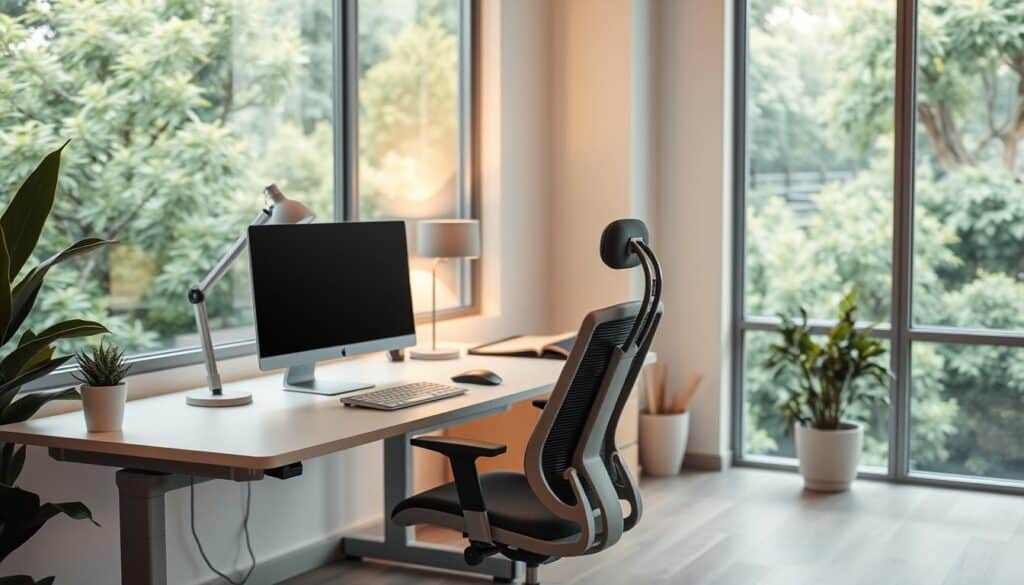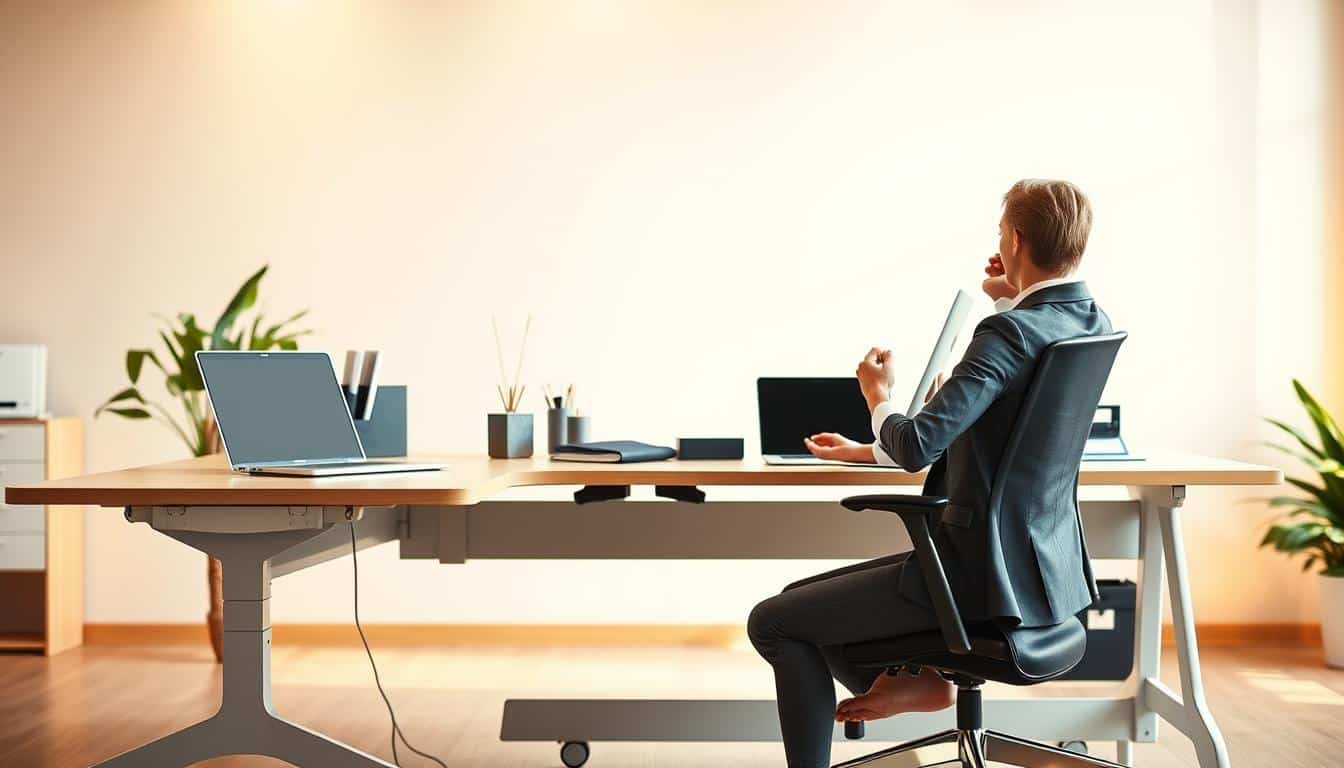Many of us work long hours at our desks, which can make us feel stiff and less flexible. Ergonomic desk stretches are key for easing pain and improving how we move. They are especially important for the 80% of Americans who sit too much at work. Knowing how these stretches help is key for staying healthy.
Poor posture and not moving enough can cause work-related health problems. By doing some simple stretches every day, you can fight these problems. Focusing on your hands, neck, shoulders, and legs can make you more flexible and less tense. As we look at different stretches, remember taking care of yourself helps you work better and do more.
Understanding the Importance of Ergonomic Desk Stretches
Stretching is super important, especially for desk-job health. Ergonomic stretches help fight the physical strains of long hours sitting. They boost blood flow and cut down the risk of musculoskeletal disorders.
Frequent stretching boosts motion range and posture, easing stress. Moves like wrist tilts and shoulder shrugs relieve tension. Short breaks for stretching can also make you more focused and productive.
Stretching every 30 minutes fights muscle stiffness and fatigue. Even quick stretches, just 30 seconds long, are really helpful. It’s also key to have a desk set-up that supports good posture. This helps avoid discomfort, like back pain and eyestrain.
Regular stretches make for a healthier workplace. This leads to happier employees and a better work culture. When ergonomics and stretching are a daily thing, everyone feels better about their job.
Common Issues Caused by Sedentary Work
Spending long hours at a desk can cause lots of health problems. Office workers sit for about 6.29 hours during a typical 8-hour day. This leads to more complaints of discomfort and pain. Roughly 73.6% of them feel very tired, with many having neck, back, and shoulder issues.
About 53.5% report neck pain while 53.2% have lower back pain. Shoulders also hurt for 51.6% of them. These problems come from sitting too much, which can also lead to serious things like high blood pressure.
Studies show that women sit more than men and thus have more musculoskeletal issues. Nearly half of the people asked said their workstations made them uncomfortable. Issues like chronic neck pain, carpal tunnel syndrome, and back pain often stem from bad posture due to not moving enough.
Being sedentary can also cause mental health problems like anxiety and depression. Too much sitting can increase the risk of heart disease and some cancers. These bad effects show why moving around and good workstation setups are vital. Doing regular stretches can help reduce these health risks.
Benefits of Incorporating Stretches into Your Work Routine
Adding stretches to your workday has many perks for those looking to feel better overall. One key benefit is avoiding the discomfort from sitting too long. Stretching helps ease muscle stiffness, which can reduce pain and promote better health. It’s also vital for keeping joints healthy and avoiding injuries by improving flexibility.
Stretching is also great for making you more productive at work. Taking short breaks to stretch can boost your energy and make your mind sharper. This not only helps you focus better but it also makes for a happier workplace. Plus, it helps lessen stress. Some research shows that workplaces with stretching programs can see discomfort drop by as much as 72%.
Stretches can help you maintain a good posture all day. They strengthen muscles that support a good posture. This lowers the risk of problems caused by bad posture. Neck, shoulder, and chest stretches can specifically help with tension from sitting at a desk.
In short, stretching has lots of benefits that go beyond just physical ones. It can improve circulation and mental health, leading to higher productivity and a less stressful office atmosphere.
How to Properly Perform Ergonomic Desk Stretches
Doing ergonomic stretches helps you feel better and stops strain when you sit long hours. You should hold each stretch for 10 to 30 seconds. This helps your muscles relax while keeping your posture right.
Here are some tips for good ergonomic stretches:
- Don’t bounce when you stretch. Move gently to relax your muscles better.
- Keep breathing normally to help your muscles relax and lower stress.
- Slowly make the stretch harder but stop if it hurts.
Try a 3-step stretch plan to solve problems like Upper Crossed Syndrome (UCS). You can do:
- Trapezius Stretches
- Prone T’s & Y’s
- Rows
Remember to take breaks every 30 to 60 minutes to move and stretch. This keeps your posture right and makes you more flexible. Just taking short walks or stretching your hands and arms can make a big difference.
The seated piriformis stretch is great to focus on. Cross your ankle over your knee, keep your back straight, lean forward, and gently push on your knee. Do this for 15 seconds each side for the best effect.
Using items like a Theracane, tennis/racket balls, or a foam roller can help too. They push on your muscles, get rid of muscle tightness, and improve blood flow. Stretch in the morning, at noon, and after work for the best health.
Ergonomic Desk Stretches for Upper Body Relief
Sitting for too long can make your upper body tense and uncomfortable. Adding stretches for your upper body to your day can really help. These moves make stiffness go away and increase flexibility.
The triceps stretch is a good place to start. Lift one arm over your head and bend it back. Use your other hand to gently push your elbow. Stay like this for 10-30 seconds then switch. This stretch focuses on the triceps and eases tension in the upper arms.
Try the Overhead Reach too. Whether standing or sitting, stretch your arms above your head and link your hands. Stretch up and lean slightly to stretch your sides. Keep this up for 10-30 seconds to feel the stretch.
The Upper Body and Arm Stretch is good for overall flexibility. Lift your arms, join your hands and hold for 10-30 seconds. It’s a good stretch for the shoulders and arms.
It’s easy to fit these stretches into your day. Try to take a break every 30 to 45 minutes to do them. Regular stretching lowers muscle tension and can even make you more productive. It’s very important for people who sit at a desk all day.
Ergonomic Desk Stretches for Lower Body Relief
Lower body stretches can help ease discomfort from sitting too long. The Hip and Knee Flexion Stretch reduces tightness by pulling one knee to your chest. It’s a simple move that makes your hips feel better.
The Hamstrings Stretch is great for easing lower back pain. Just extend one leg and reach towards your toes for 30 seconds. Then do the same with the other leg. This balances relief across both hamstrings.
Other helpful stretches are:
- Trunk Rotation Stretch: Sit up and twist from side to side, holding your chair, for 15 seconds.
- Seated Forward Flexion Stretch: Bend forward to loosen your lower back and hamstrings for 30 seconds.
- Standing Desk Hamstring Stretch: Put one leg on a chair and lean into it for 30 seconds.
- Seated Figure Four Stretch: Cross one leg over, lean forward, and hold for 30 seconds to stretch the hips.
Doing these stretches can improve your flexibility and posture. They also help prevent injuries. Adding these stretches to your day helps keep your spine moving right. This is key for anyone who sits at a desk all day.
Stretching the Neck and Shoulders
Adding neck stretches to your day can make your shoulders feel better. It also helps with neck care. These stretches relax tight muscles and prevent pain from sitting too long.
The Lateral Neck Flexion Stretch is a good move. Put your fingers on your head and gently pull to one side. You should feel your neck stretching. Stay like this for 10-15 seconds, then do the other side.
Try the Forward Flexion Stretch too. Tilt your head down and touch your chin to your chest. Then, move your ear toward your shoulder with your hand for more stretch. Hold it for 10-15 seconds and then switch.
The Chin Tuck targets the back of your neck. Just drop your chin to your chest and hold it. Do this several times a day for better neck muscles and care.
Shoulder Warm Up exercises help with shoulder tension. Lock your fingers with palms out and stretch your arms in front at chest level for 15 seconds. Then, lock fingers behind you, palms out, and hold for 15 seconds.
Add Shoulder Rolls to your routine for more relief. Raise your shoulders up, then roll them back and down. Take deep breaths while doing this. It feels really good.
Shrugging your shoulders works well too. Breathe in and lift your shoulders up, then exhale and roll them back. Do this ten times for better comfort.
To stretch further, tilt your head from side to side. This means leaning your head toward a shoulder and rolling the other shoulder down. After, come back to the middle. Do it on both sides.
For a more focused stretch, point your chin to your shoulder. Move your chin toward one shoulder and use your other hand to pull gently. Keep this for 5-10 seconds before switching sides.
To open up, sit up straight and clasp your hands behind you. Press your palms together and roll your shoulders back. If you can, tilt your head back to open your chest.
While neck circles might seem good, they can actually hurt your spine and increase neck pain. Stick to the stretches mentioned here for safe neck care. Try to do these stretches daily and walk around every hour for the best effect.
Incorporating Movement into Your Workday
It’s key to move around during your workday for better health and productivity. Simple changes, like being more active at work, can greatly improve your well-being. Moving around at work means taking regular breaks and making physical activity a part of the day.
Here are some great break ideas to keep you energized and reduce the stiffness from sitting too long:
- Standing Hip Stretch: Improves hip mobility and reduces lower back pain. This can be done briefly during calls.
- Calf Raises: Strengthens calves while enhancing ankle mobility. Perform these while waiting for documents to print.
- Wall Sits: Great for strengthening quadriceps and glutes. Aim for a 30-second hold against the wall.
- Shoulder Blade Squeeze: Helps improve posture and alleviates neck and shoulder pain. Do this while seated to remind your muscles to engage.
- Desk Push-Ups: Strengthens the chest, arms, and shoulders without the need for equipment.
- Desk Squats and Lunges: These are perfect for working the legs and glutes during short breaks.
- Chair Leg Extensions: Strengthens legs while seated, enhancing flexibility and circulation.
By adding these exercises to your routine, you’ll boost blood circulation, lower stress, and clear your mind. An active workday creates a healthier workplace, boosting your focus and productivity. Including these exercises in your day can change how you feel at work.
Tips for Creating a Stretch-Friendly Workspace
Designing a workspace that’s good for stretching is key. It should encourage movement and regular stretching. This helps both employees and their work.
Here are some tips for making your workspace stretch-friendly:
- Take Regular Breaks: Use a timer to remind yourself to take a break every hour. Spend some time standing or walking.
- Vary Work Tasks: Try to switch between sitting and standing. Do tasks that get you moving.
- Eye Exercises: Look at something far away now and then to rest your eyes from screens.
Adding stretches into your day is great for your health:
- Hand and Wrist Stretches:
- Make a fist, then stretch your fingers up your palm.
- Move your wrist side to side gently. Hold each side for a few seconds.
- Shoulder and Neck Exercises:
- Lift your shoulders up towards your ears. Hold and then repeat.
- Lean your head to the side and then gently turn it.
- Back and Leg Stretches:
- Hug your shin and bend over, trying to touch your knee with your nose.
- Cross one leg over the other and press lightly.
Follow these rules when stretching:
- Stretch for 10-20 seconds each time.
- Keep breathing normally while you stretch.
- Don’t bounce or lock your joints. If it hurts, stop.
Having an ergonomic setup and encouraging stretching can make you healthier. Apps like StretchClock remind you to stretch and take breaks.

Conclusion
In conclusion, adding ergonomic stretches to your daily life is key for desk job workers. Moving often is crucial because it helps ease pain, makes you more flexible, and keeps you healthier at your desk. Studies show that the right stretches can cut down on back pain and boost blood flow, making for a better work space.
Also, doing desk stretches regularly can make you more productive, think clearer, and feel less stressed at work. Even quick and easy stretches can fight off the bad effects of sitting too long. If you stretch and move every 30 minutes, you’ll see lasting perks like good posture and less chronic pain.
In the end, it’s important to pick stretches that fit your own needs and the space you have. By focusing on ergonomic stretches, both workers and their companies will see great gains in health and work efficiency. This will lead to a happier workplace where pain and discomfort are much lower.



